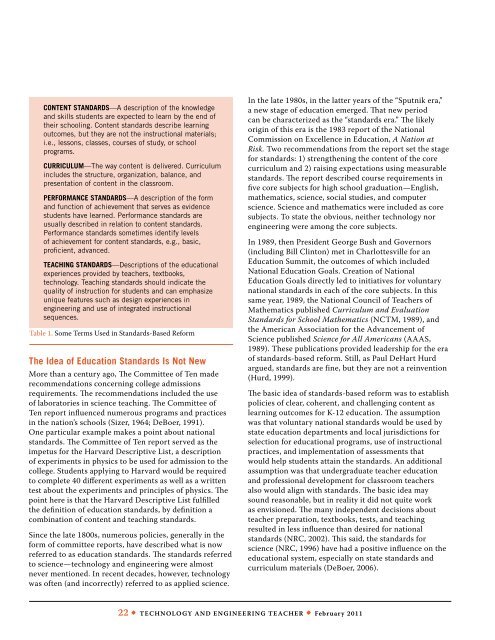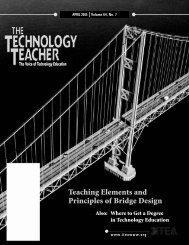K-12 Engineering Education Standards: - International Technology ...
K-12 Engineering Education Standards: - International Technology ...
K-12 Engineering Education Standards: - International Technology ...
You also want an ePaper? Increase the reach of your titles
YUMPU automatically turns print PDFs into web optimized ePapers that Google loves.
CONTENT STANDARDS—A description of the knowledge<br />
and skills students are expected to learn by the end of<br />
their schooling. Content standards describe learning<br />
outcomes, but they are not the instructional materials;<br />
i.e., lessons, classes, courses of study, or school<br />
programs.<br />
CURRICULUM—The way content is delivered. Curriculum<br />
includes the structure, organization, balance, and<br />
presentation of content in the classroom.<br />
PERFORMANCE STANDARDS—A description of the form<br />
and function of achievement that serves as evidence<br />
students have learned. Performance standards are<br />
usually described in relation to content standards.<br />
Performance standards sometimes identify levels<br />
of achievement for content standards, e.g., basic,<br />
proficient, advanced.<br />
TEACHING STANDARDS—Descriptions of the educational<br />
experiences provided by teachers, textbooks,<br />
technology. Teaching standards should indicate the<br />
quality of instruction for students and can emphasize<br />
unique features such as design experiences in<br />
engineering and use of integrated instructional<br />
sequences.<br />
Table 1. Some Terms Used in <strong>Standards</strong>-Based Reform<br />
The Idea of <strong>Education</strong> <strong>Standards</strong> Is Not New<br />
More than a century ago, The Committee of Ten made<br />
recommendations concerning college admissions<br />
requirements. The recommendations included the use<br />
of laboratories in science teaching. The Committee of<br />
Ten report influenced numerous programs and practices<br />
in the nation’s schools (Sizer, 1964; DeBoer, 1991).<br />
One particular example makes a point about national<br />
standards. The Committee of Ten report served as the<br />
impetus for the Harvard Descriptive List, a description<br />
of experiments in physics to be used for admission to the<br />
college. Students applying to Harvard would be required<br />
to complete 40 different experiments as well as a written<br />
test about the experiments and principles of physics. The<br />
point here is that the Harvard Descriptive List fulfilled<br />
the definition of education standards, by definition a<br />
combination of content and teaching standards.<br />
Since the late 1800s, numerous policies, generally in the<br />
form of committee reports, have described what is now<br />
referred to as education standards. The standards referred<br />
to science—technology and engineering were almost<br />
never mentioned. In recent decades, however, technology<br />
was often (and incorrectly) referred to as applied science.<br />
In the late 1980s, in the latter years of the “Sputnik era,”<br />
a new stage of education emerged. That new period<br />
can be characterized as the “standards era.” The likely<br />
origin of this era is the 1983 report of the National<br />
Commission on Excellence in <strong>Education</strong>, A Nation at<br />
Risk. Two recommendations from the report set the stage<br />
for standards: 1) strengthening the content of the core<br />
curriculum and 2) raising expectations using measurable<br />
standards. The report described course requirements in<br />
five core subjects for high school graduation—English,<br />
mathematics, science, social studies, and computer<br />
science. Science and mathematics were included as core<br />
subjects. To state the obvious, neither technology nor<br />
engineering were among the core subjects.<br />
In 1989, then President George Bush and Governors<br />
(including Bill Clinton) met in Charlottesville for an<br />
<strong>Education</strong> Summit, the outcomes of which included<br />
National <strong>Education</strong> Goals. Creation of National<br />
<strong>Education</strong> Goals directly led to initiatives for voluntary<br />
national standards in each of the core subjects. In this<br />
same year, 1989, the National Council of Teachers of<br />
Mathematics published Curriculum and Evaluation<br />
<strong>Standards</strong> for School Mathematics (NCTM, 1989), and<br />
the American Association for the Advancement of<br />
Science published Science for All Americans (AAAS,<br />
1989). These publications provided leadership for the era<br />
of standards-based reform. Still, as Paul DeHart Hurd<br />
argued, standards are fine, but they are not a reinvention<br />
(Hurd, 1999).<br />
The basic idea of standards-based reform was to establish<br />
policies of clear, coherent, and challenging content as<br />
learning outcomes for K-<strong>12</strong> education. The assumption<br />
was that voluntary national standards would be used by<br />
state education departments and local jurisdictions for<br />
selection for educational programs, use of instructional<br />
practices, and implementation of assessments that<br />
would help students attain the standards. An additional<br />
assumption was that undergraduate teacher education<br />
and professional development for classroom teachers<br />
also would align with standards. The basic idea may<br />
sound reasonable, but in reality it did not quite work<br />
as envisioned. The many independent decisions about<br />
teacher preparation, textbooks, tests, and teaching<br />
resulted in less influence than desired for national<br />
standards (NRC, 2002). This said, the standards for<br />
science (NRC, 1996) have had a positive influence on the<br />
educational system, especially on state standards and<br />
curriculum materials (DeBoer, 2006).<br />
22 • <strong>Technology</strong> and <strong>Engineering</strong> Teacher • February 2011
















